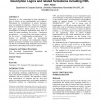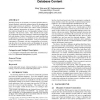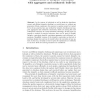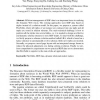201 search results - page 18 / 41 » Semantic Foundations of 4NF in Relational Database Design |
KCAP
2003
ACM
14 years 20 days ago
2003
ACM
Modularity is a key requirement for large ontologies in order to achieve re-use, maintainability, and evolution. Mechanisms for ‘normalisation’ to achieve analogous aims are s...
WWW
2007
ACM
14 years 8 months ago
2007
ACM
With the growing use of dynamic web content generated from relational databases, traditional caching solutions for throughput and latency improvements are ineffective. We describe...
CORR
2008
Springer
13 years 7 months ago
2008
Springer
Provenance is information about the origin, derivation, ownership, or history of an object. It has recently been studied extensively in scientific databases and other settings due...
FQAS
2004
Springer
13 years 11 months ago
2004
Springer
In the context of relational as well as deductive databases, correct and efficient integrity checking is a crucial issue, as, without any guarantee of data consistency, the answers...
DASFAA
2010
IEEE
13 years 11 months ago
2010
IEEE
Efficient management of RDF data is an important factor in realizing the Semantic Web vision. The existing approaches store RDF data based on triples instead of a relation model. I...




